Ever wondered if spruce trees could harm your curious cat? Understanding the potential toxicity of these evergreens is vital for your pet's well-being. As a responsible pet owner, it's crucial to be aware of the risks in your surroundings.
Before dismissing the idea, consider the importance of knowing about potential hazards. Stay informed about the impact of spruce trees on your furry friend's health.
Types of Spruce Trees
Exploring the diverse types of spruce trees can open up a world of beauty and practical benefits for your landscaping and environment.
Two common types are the Norway spruce and the Colorado spruce. The Norway spruce, with its elegant, drooping branches and dark green needles, is often used for windbreaks and erosion control. Its wood is valued in construction and making musical instruments.
On the other hand, the Colorado spruce, known for its striking blue-green hue and symmetrical shape, is a favorite for ornamental planting. It provides excellent shade and nesting sites for birds.
Understanding the distinct features of these spruce trees can help you identify and maximize their benefits in your surroundings, whether for enhancing your landscape's aesthetics or supporting local wildlife.
Potential Toxins in Spruce Trees
After learning about the diverse types of spruce trees, it's important to be aware of potential toxins that may be present in these trees and their impact on the environment and wildlife. When it comes to spruce trees, it's crucial to consider the following:
- Identifying toxic compounds: Some spruce trees contain compounds such as isocupressic acid, which can be toxic to animals.
- Toxicity in other animals: While cats may not be as affected by these toxins, other animals like horses and cattle are susceptible to poisoning from certain parts of spruce trees.
- Environmental impact: The presence of toxic compounds in spruce trees can have detrimental effects on the surrounding ecosystem and wildlife.
- Preventive measures: Understanding the potential toxins in spruce trees can help in taking preventive measures to protect animals and the environment.
Being knowledgeable about these potential toxins is crucial for ensuring the safety of animals and the ecosystem.
Symptoms of Spruce Tree Toxicity in Cats
If your cat has been exposed to toxins from spruce trees, it's important to be able to recognize the symptoms of toxicity and take prompt action.
Symptoms of spruce tree toxicity in cats may include:
- Vomiting
- Diarrhea
- Drooling
- Lethargy
- Lack of appetite
- In severe cases, difficulty breathing, tremors, and seizures.
If you notice any of these signs and suspect that your cat has ingested spruce tree toxins, it's crucial to seek veterinary care immediately.
Your veterinarian can provide the necessary treatment and supportive care to help your cat recover from plant toxicity.
Remember that early intervention is key in cases of potential poisoning, so don't hesitate to contact your veterinarian if you suspect your cat has been affected.
Treatment for Spruce Tree Toxicity
If your cat is showing symptoms of spruce tree toxicity, seeking prompt veterinary care is crucial for providing the necessary treatment and supportive care to aid in their recovery. Emergency care and veterinary assistance are essential to address spruce tree toxicity in cats. Here's what you can expect in terms of treatment for your cat:
- Decontamination: Your veterinarian may induce vomiting or administer activated charcoal to help eliminate any remaining toxins from your cat's system.
- Supportive Care: This may include intravenous fluids to maintain hydration and support kidney function.
- Medication: Depending on the symptoms, your cat may receive medications to control seizures, alleviate gastrointestinal distress, or manage any other complications.
- Monitoring: Your cat will likely require close monitoring to track their progress and ensure they're responding well to treatment.
Preventing Spruce Tree Toxicity
To prevent spruce tree toxicity in your cat, there are several steps you can take.
First, carefully monitor your cat's access to potentially harmful plants in your home and outdoor environment. This includes keeping an eye on any spruce trees or other toxic plants that may be present.
Consider providing safe alternatives for your cat, such as cat-friendly plants like catnip, cat thyme, or cat grass. These can offer environmental enrichment while keeping your cat away from toxic greenery.
Place spruce trees and other potentially toxic plants in areas that are inaccessible to your cat. This could mean placing them on high shelves or in enclosed outdoor spaces.
In addition to monitoring and providing safe alternatives, it's important to keep your cat mentally stimulated. Invest in interactive toys and scratching posts to keep them entertained and less likely to munch on plants out of boredom.
Conclusion
In a world where we cherish our feline companions, it's crucial to be mindful of potential hazards like spruce trees.
Being vigilant for signs of toxicity and creating a safe environment for our cats is a simple yet powerful way to show our care.
After all, their well-being is worth every effort.

My interest in trees started when I first saw the giant sequoias in Yosemite.
I was a teenager then, and I remember thinking, “I need to learn more about this.”
That moment stuck with me.
A few years later, I went on to study forestry at Michigan Tech.
Since graduating, I’ve worked in a mix of hands-on tree care and community education.
I’ve spent over ten years helping people understand how to plant, maintain, and protect the trees in their neighborhoods.
I don’t see trees as just part of the landscape.
They are living things that make a real difference in our daily lives.
